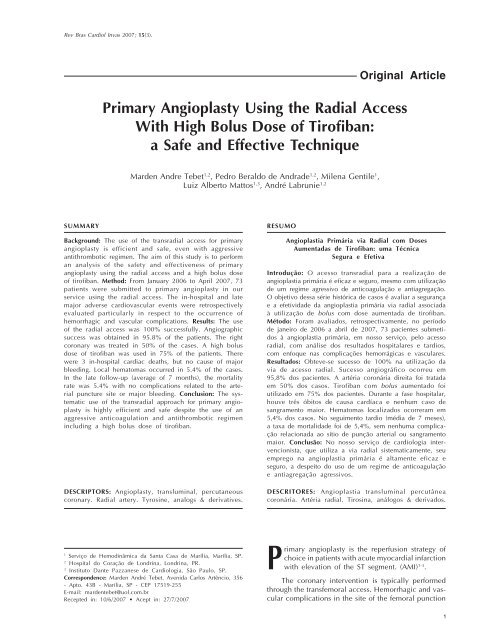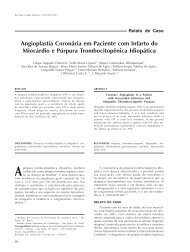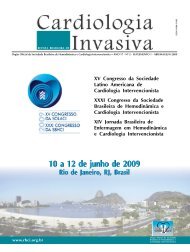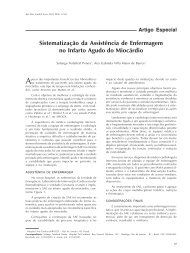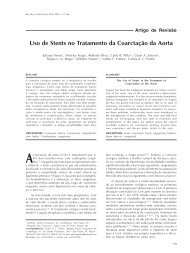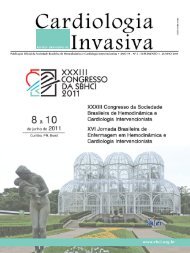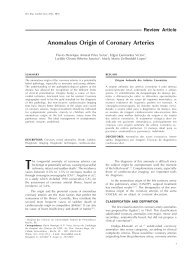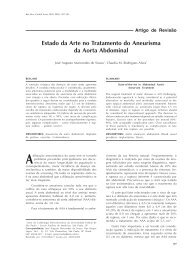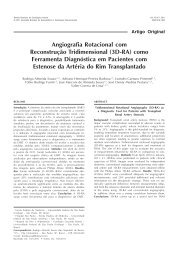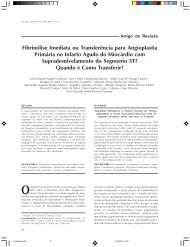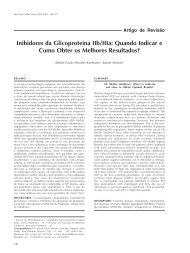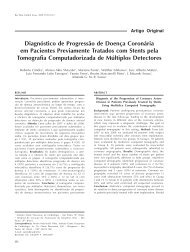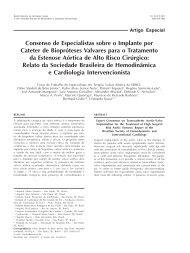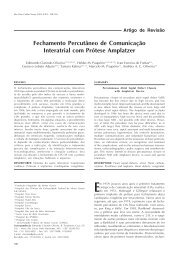Marden Tabet ING.pmd - Revista Brasileira de Cardiologia Invasiva
Marden Tabet ING.pmd - Revista Brasileira de Cardiologia Invasiva
Marden Tabet ING.pmd - Revista Brasileira de Cardiologia Invasiva
Create successful ePaper yourself
Turn your PDF publications into a flip-book with our unique Google optimized e-Paper software.
Rev Bras Cardiol Invas 2007; 15(3).<br />
Tebet MA, et al. Primary Angioplasty Using the Radial Access With High Bolus Dose of Tirofiban: a Safe and Effective Technique.<br />
Rev Bras Cardiol Invas 2007; 15(3).<br />
SUMMARY<br />
Primary Angioplasty Using the Radial Access<br />
With High Bolus Dose of Tirofiban:<br />
a Safe and Effective Technique<br />
<strong>Mar<strong>de</strong>n</strong> Andre Tebet 1,2 , Pedro Beraldo <strong>de</strong> Andra<strong>de</strong> 1,2 , Milena Gentile 1 ,<br />
Luiz Alberto Mattos 1,3 , André Labrunie 1,2<br />
Background: The use of the transradial access for primary<br />
angioplasty is efficient and safe, even with aggressive<br />
antithrombotic regimen. The aim of this study is to perform<br />
an analysis of the safety and effectiveness of primary<br />
angioplasty using the radial access and a high bolus dose<br />
of tirofiban. Method: From January 2006 to April 2007, 73<br />
patients were submitted to primary angioplasty in our<br />
service using the radial access. The in-hospital and late<br />
major adverse cardiovascular events were retrospectively<br />
evaluated particularly in respect to the occurrence of<br />
hemorrhagic and vascular complications. Results: The use<br />
of the radial access was 100% successfully. Angiographic<br />
success was obtained in 95.8% of the patients. The right<br />
coronary was treated in 50% of the cases. A high bolus<br />
dose of tirofiban was used in 75% of the patients. There<br />
were 3 in-hospital cardiac <strong>de</strong>aths, but no cause of major<br />
bleeding. Local hematomas occurred in 5.4% of the cases.<br />
In the late follow-up (average of 7 months), the mortality<br />
rate was 5.4% with no complications related to the arterial<br />
puncture site or major bleeding. Conclusion: The systematic<br />
use of the transradial approach for primary angioplasty<br />
is highly efficient and safe <strong>de</strong>spite the use of an<br />
aggressive anticoagulation and antithrombotic regimen<br />
including a high bolus dose of tirofiban.<br />
DESCRIPTORS: Angioplasty, transluminal, percutaneous<br />
coronary. Radial artery. Tyrosine, analogs & <strong>de</strong>rivatives.<br />
1 Serviço <strong>de</strong> Hemodinâmica da Santa Casa <strong>de</strong> Marília, Marília, SP.<br />
2 Hospital do Coração <strong>de</strong> Londrina, Londrina, PR.<br />
3 Instituto Dante Pazzanese <strong>de</strong> <strong>Cardiologia</strong>, São Paulo, SP.<br />
Correspon<strong>de</strong>nce: <strong>Mar<strong>de</strong>n</strong> André Tebet. Avenida Carlos Artêncio, 356<br />
- Apto. 43B - Marília, SP - CEP 17519-255<br />
E-mail: mar<strong>de</strong>ntebet@uol.com.br<br />
Recepted in: 10/6/2007 Acept in: 27/7/2007<br />
RESUMO<br />
Original Article<br />
Angioplastia Primária via Radial com Doses<br />
Aumentadas <strong>de</strong> Tirofiban: uma Técnica<br />
Segura e Efetiva<br />
Introdução: O acesso transradial para a realização <strong>de</strong><br />
angioplastia primária é eficaz e seguro, mesmo com utilização<br />
<strong>de</strong> um regime agressivo <strong>de</strong> anticoagulação e antiagregação.<br />
O objetivo <strong>de</strong>ssa série histórica <strong>de</strong> casos é avaliar a segurança<br />
e a efetivida<strong>de</strong> da angioplastia primária via radial associada<br />
à utilização <strong>de</strong> bolus com dose aumentada <strong>de</strong> tirofiban.<br />
Método: Foram avaliados, retrospectivamente, no período<br />
<strong>de</strong> janeiro <strong>de</strong> 2006 a abril <strong>de</strong> 2007, 73 pacientes submetidos<br />
à angioplastia primária, em nosso serviço, pelo acesso<br />
radial, com análise dos resultados hospitalares e tardios,<br />
com enfoque nas complicações hemorrágicas e vasculares.<br />
Resultados: Obteve-se sucesso <strong>de</strong> 100% na utilização da<br />
via <strong>de</strong> acesso radial. Sucesso angiográfico ocorreu em<br />
95,8% dos pacientes. A artéria coronária direita foi tratada<br />
em 50% dos casos. Tirofiban com bolus aumentado foi<br />
utilizado em 75% dos pacientes. Durante a fase hospitalar,<br />
houve três óbitos <strong>de</strong> causa cardíaca e nenhum caso <strong>de</strong><br />
sangramento maior. Hematomas localizados ocorreram em<br />
5,4% dos casos. No seguimento tardio (média <strong>de</strong> 7 meses),<br />
a taxa <strong>de</strong> mortalida<strong>de</strong> foi <strong>de</strong> 5,4%, sem nenhuma complicação<br />
relacionada ao sítio <strong>de</strong> punção arterial ou sangramento<br />
maior. Conclusão: No nosso serviço <strong>de</strong> cardiologia intervencionista,<br />
que utiliza a via radial sistematicamente, seu<br />
emprego na angioplastia primária é altamente eficaz e<br />
seguro, a <strong>de</strong>speito do uso <strong>de</strong> um regime <strong>de</strong> anticoagulação<br />
e antiagregação agressivos.<br />
DESCRITORES: Angioplastia transluminal percutânea<br />
coronária. Artéria radial. Tirosina, análogos & <strong>de</strong>rivados.<br />
Primary angioplasty is the reperfusion strategy of<br />
choice in patients with acute myocardial infarction<br />
with elevation of the ST segment. (AMI) 1-3 .<br />
The coronary intervention is typically performed<br />
through the transfemoral access. Hemorrhagic and vascular<br />
complications in the site of the femoral punction<br />
1
Tebet MA, et al. Primary Angioplasty Using the Radial Access With High Bolus Dose of Tirofiban: a Safe and Effective Technique.<br />
Rev Bras Cardiol Invas 2007; 15(3).<br />
can bring about a significant increase of complications,<br />
time of stay in hospital and cost of the procedure,<br />
especially when the angioplasty is performed un<strong>de</strong>r<br />
the aggressive regime of anticoagulation and antiplatelet<br />
therapy, especially with the use of glico-protein inhibitors<br />
Iib/IIIa (GPI) 4 .<br />
The use of the transradial access is based on the<br />
reduction of hemorrhagic complications in the vascular<br />
access site and long rest in bed. Several studies have<br />
confirmed its applicability and potential advantages<br />
over the femoral approach 5-9 , with equal success and<br />
less hemorrhagic complications, even with the use of<br />
an aggressive anti thrombotic regime, including GPI 4.<br />
In spite of some conflicting results, studies have<br />
established the safety and efficacy of GPIs during primary<br />
angioplasty 10-13 . The current gui<strong>de</strong>lines specifically recommend<br />
the use of abciximab during primary PCI as<br />
a class I 3 indication.<br />
In patients with acute coronary syndromes, the TAR-<br />
GET 14 study showed less efficacy of tirofiban when compared<br />
to abciximab. It is believed that this is due to, mainly,<br />
to an ina<strong>de</strong>quate platelet inhibition in the first hours after<br />
administering tirofiban during the procedure 14-19 . The use<br />
of bolus with an increased dose of tirofiban have shown<br />
platelet inhibition and similar clinical results to those<br />
found with abciximab 20-22 . The substitution of abciximab<br />
for tirofiban, administered with a bolus regime with increased<br />
dose, is a promising strategy, which might show itself to<br />
be cost effective.<br />
The objective of this study is to assess the effectiveness<br />
of primary angioplasty through the radius associated<br />
to the use of bolus with an increased dose of<br />
tirofiban.<br />
METHOD<br />
Between January 2006 and May 2007, 79 patients<br />
with AMI with augmented ST segment were submitted<br />
to primary angioplasty in our service. Seventy-three<br />
patients ma<strong>de</strong> up the sample (92%). Six patients were<br />
exclu<strong>de</strong>d from the sample due to the non-use of the<br />
radial technique: three for lack of radial pulse (two for<br />
previous use of the Sones technique and one due to<br />
previous catheterism and angioplasty through direct<br />
radial approach), two for cardiogenic shock and total<br />
atria ventricular blockage with the need of a temporary<br />
pacemaker, and another patient who evolved with<br />
coronary embolization during an hemodynamic study<br />
for mitral valvulopathy.<br />
Late follow up was obtained in all the patients, either<br />
through their case histories or through telephone calls.<br />
The choice vessel was the right radial. The choice<br />
of the radial technique occurred through the Allen<br />
modified test. If the test were negative, the other vessel<br />
used was the left radial. Short introducers (8 cmts)<br />
were used: French 6. A solution with 5000 UI of heparin<br />
2<br />
sulfate and 10 mg of issosorbi<strong>de</strong> mononitrate was<br />
injected through the introducer. The procedures were<br />
performed with the habitual techniques. Stents were<br />
implanted with the direct or conventional technique.<br />
The removal of the introducers was performed immediately<br />
after the procedure; the haemeostasis was done<br />
with a porous compressive elastic bandage (Tensoplast ® ),<br />
for about four hours. After this period, compression was<br />
relaxed and a small sticking plaster was used during<br />
24 hours. There was no need of haemostatic <strong>de</strong>vices.<br />
The functional circulation of the hand was verified<br />
after one hour.<br />
All patients received 300 mg of aspirin in the<br />
emergency room. Clopidogrel was administered in the<br />
hemodynamic room, using a dose of 300 mg or 600 mg<br />
respectively, with or without tirofiban. Non-fractioned<br />
Heparin was used in all the patients in a total dose of<br />
100 U/kg. Tirofiban was used at the discretion of the<br />
operator, in the dose of 25 u/kg in 3-minute bolus and<br />
in the maintenance dose of 1.5 u/kg/min for 12 – 18<br />
hours. A catheter for the aspiration of coronary thrombi<br />
was also used at the operator’s discretion (Pronto ® ).<br />
The outcomes used were: angiographic success<br />
(percentual of the diameter of the stenosis of the target<br />
vessel < 20% and coronary flux in the target vessel<br />
TIMI 3), general in-hospital <strong>de</strong>ath, complications in<br />
the arterial access – such as major bleeding (<strong>de</strong>terminers<br />
of a long hospital stay, surgical intervention, blood<br />
transfusion or hemorrhagic stroke), arterio-venous fistulae,<br />
ischemia of the limb with the need of vascular<br />
surgery and failure of the procedure, <strong>de</strong>fined as the<br />
need of a second vessel entry or failure of the procedure<br />
due to the impossibility of canalization of the radial<br />
artery or conclusion of the coronary angioplasty or<br />
due to a major complication in the site of the arterial<br />
punction.<br />
The continuous variables were expressed in medians<br />
and standard <strong>de</strong>viation and, the categorical variables,<br />
in absolute numbers and their percentual.<br />
RESULTS<br />
The majority (73.8%) of the patients were male.<br />
There was a low inci<strong>de</strong>nce of patients with a previous<br />
history of myocardial infarction, coronary angioplasty<br />
and myocardial revascularization surgery. The <strong>de</strong>mographic<br />
data is in Table 1. Most of the patients were<br />
unilateral and there was a higher striking of the right<br />
coronary artery (Table 2). Angiographically visible<br />
thrombi occurred in 18 (24.6%) of the patients but<br />
thrombectomy was performed in only 22% of that<br />
population, beginning in October 2006). The bolus<br />
regime, with increased dose of tirofiban, was used in<br />
74% of the patients. In our sample, seven (9.5%) of the<br />
patients were 75 years old or more and out of these,<br />
four (5.4%) used tirofiban without any bleeding episo<strong>de</strong>s,<br />
neither major nor minor. Heparin was not used
Tebet MA, et al. Primary Angioplasty Using the Radial Access With High Bolus Dose of Tirofiban: a Safe and Effective Technique.<br />
Rev Bras Cardiol Invas 2007; 15(3).<br />
after the procedure. Stents were implanted in 69 (94.5%)<br />
of the patients. All exams were performed successfully<br />
through the radial access. The catheters used for the<br />
left and right coronary arteries were the extra back-up<br />
(85%) for the left and Judkins for the right artery (86%),<br />
respectively. Angiographic success took place in 70<br />
(95.8%) of the patients.<br />
Table 3 shows the occurrence of major adverse<br />
events. There were three in-hospital <strong>de</strong>aths. One hap-<br />
TABLE 1<br />
Basic Characteristics<br />
Basic Characteristics Total (n=73)<br />
Mean age 60.8±10.4<br />
Male gen<strong>de</strong>r (%) 51 (69.8)<br />
HAS (%) 50 (68.4)<br />
Diabetes (%) 15 (20.5)<br />
Dislipi<strong>de</strong>mia (%) 26 (35.6)<br />
Family History of ICO (%) 8 (10.9)<br />
Previous AMI (%) 4 (5.4)<br />
Smoking (%) 35 (47.9)<br />
Revascularization surgery (%) 0 (0)<br />
Previous Angioplasty (%) 1 (1.3)<br />
TABLE 2<br />
Angiographic and Total<br />
Procedural Characteristics<br />
Angiographic and procedural Total (n=73)<br />
characteristics<br />
Number of vessels treated<br />
Single artery (%) 35 (47.9)<br />
Bi-artery (%) 23 (31.5)<br />
Tri-artery (%) 15 (20.5)<br />
Vessels treated<br />
DA (%) 30 (41.1)<br />
CX (%) 6 (8.2)<br />
CD (%) 37 (50.6)<br />
Angiographic Thrombus (%) 18 (24.6)<br />
Balloon time (min) 84.3±26.5<br />
Pre TIMI Flux<br />
TIMI 0/1 pre (%) 61 (83.5)<br />
TIMI 2/3 pre (%) 12 (16.4)<br />
Tirofiban Bolus 25 µ/Kg. (%) 54 (74)<br />
Aspiration Catheter (%) 4 (5.4)<br />
Stent implant (%) 69 (94.5)<br />
Post TIMI Flux<br />
TIMI 0/1 post (%) 3 (4.1)<br />
TIMI 2/3 post (%) 70 (95.8)<br />
Angiographic Success (%) 70 (95.8)<br />
pened 12 hours after angioplasty, which was angiographically<br />
successful, due to refractory ventricular fibrillation.<br />
The second <strong>de</strong>ath occurred on the fourth day of<br />
hospitalization, after an unsuccessful angiography (noreflow),<br />
due to refractory cardiogenic shock. The last<br />
patient, admitted for extensive anterior AMI with a 10hour<br />
evolution, presented an angiographic thrombi, more<br />
than 15 mm in extension, without solution through thrombectomy,<br />
GPI and coronary angioplasty, with no-reflow,<br />
died on the second day due to cardiogenic shock.<br />
The late follow up was obtained in 70% of the<br />
patients. During the intermediate follow up, at seven<br />
months, four (5.4%) more <strong>de</strong>aths took place. Of these,<br />
3 happened in the third month after the acute episo<strong>de</strong><br />
and probably due to a cardiac etiology; one patient<br />
presented acute inflammatory abdomen and died in<br />
the fourth month after the AMI. There were no other<br />
complications. There was one episo<strong>de</strong> of subacute<br />
stent thrombosis, during the first week after the procedure,<br />
treated through a new coronary angioplasty, with clinical<br />
success (Table 3).<br />
No major bleeding was i<strong>de</strong>ntified during the inhospital<br />
period. There was no need of a surgical procedure<br />
in the site of the radial punction, blood transfusion,<br />
lengthening of the hospitalization period, no<br />
hemorragic brain stroke episo<strong>de</strong> or bowel bleeding.<br />
There were four cases of hematoma in the site of the<br />
punction, however, without e<strong>de</strong>ma or hand ischemia.<br />
There was one case of localized flebitis which respon<strong>de</strong>d<br />
to clinical treatment.<br />
DISCUSSION<br />
The results of this analysis prove the safety and<br />
efficacy of the transradial access in primary angioplasty,<br />
even with the use of tirofiban, in bolus regime, with<br />
increased dose.<br />
The success of the transradial approach in this<br />
sample is due to the systematic use in our service.<br />
During the same period of the analysis, we performed<br />
327 elective angioplasties (Figure 1). The radial approach<br />
was used in 302 (92.4%) patients, and the femoral in<br />
TABLE 3<br />
Occurrence of events<br />
Clinical Events Total (n=73)<br />
Hospital <strong>de</strong>ath (%) 3 (4.1)<br />
Late follow up (%) 51 (69.8)<br />
Time of follow up (months) 7.26±4.9<br />
Late <strong>de</strong>ath (%) 4 (5.4)<br />
Re-infarction (%) 1 (1.3)<br />
Emergency revascularization (%) 1 (1.3)<br />
Major bleeding 0<br />
Minor bleeding 4 (5.4)<br />
3
Tebet MA, et al. Primary Angioplasty Using the Radial Access With High Bolus Dose of Tirofiban: a Safe and Effective Technique.<br />
Rev Bras Cardiol Invas 2007; 15(3).<br />
Figure 1 - Means of access used in elective angioplasties during<br />
the period from January 2006 until May 2007.<br />
the rest. The success in the elective angioplasties was<br />
98.5%, with ballon angioplasties only in only 5 (1.5%)<br />
patients. The 6F caliber introducers were used in 294<br />
patients (97.3%0, in 3 (0.9%) of patients we used 5F<br />
introducers and, in 5 (1.5%), 7F caliber introducers.<br />
When the right radial approach was not possible, we<br />
opted for the left radial artery for the performance of<br />
the procedure. In cases on which a temporary pacemaker<br />
was necessary, we used the radial access associated<br />
to punction of the jugular vein or even to the<br />
punction of the femoral vein.<br />
This routine access, for the performance of primary<br />
angioplasty, was only implanted after a learning curve<br />
period of the operators, in accordance with several<br />
studies that highlight its importance 23-26 .<br />
In our patients group, there was a predominance<br />
of AMI of the lower wall, clinically stable in most<br />
cases. An eventual major clinical instability, would<br />
potencially contribute negatively to the clinical success<br />
and would <strong>de</strong>termine a higher necessity for the use of<br />
intra-aorta balloon use, which might result in a lower<br />
use of the radial access.<br />
In spite of it having become an option over ten<br />
years ago, for the performance of coronary angioplasty,<br />
in our midst, the radial access is still not much used.<br />
Araújo and Mangione 27 assesed 53.777 patients submitted<br />
to coronary intervention enrolled in the CENIC<br />
(Centro Nacional <strong>de</strong> Intervenciones Vasculares – National<br />
Center of Vascular Intervention). Out of these, 48.455<br />
patients un<strong>de</strong>rwent elective coronary angioplasty and<br />
5.322 in the course of infarct. The radial access was<br />
used only in 10.1% of the elective cases and in 4.6%<br />
in the infarct case patients, with the femoral approach<br />
used in 87.7% of the elective cases and in 91.7 of the<br />
emergencies. It was noticed, that in our country, the<br />
radial access is used in selected patients (Male, with<br />
only one lesion and who had not un<strong>de</strong>rgone previous<br />
surgical revascularization). Patients with more serious<br />
illness are selected for femoral access.<br />
After its introduction by Kiemeneij and Laarman 28 ,<br />
the benefits of the radial technique have been clearly<br />
<strong>de</strong>monstrated in several studies 7 . Hemorragic complications<br />
in the access site are virtually eliminated. After<br />
the procedure, walking and hospital discharge are more<br />
precocious 8 . The morbidity of the procedure is lower<br />
4<br />
and the patients <strong>de</strong>ffinitely prefer this approach to the<br />
transfemoral one 8,29 .<br />
Several studies prove the efficacy and safety of the<br />
radial approach in patients submitted to primary angioplasty<br />
4, 30, 31 . Saito et al. 31 , randomized 213 patients<br />
with AMI within the first 12 hours of the beginning of<br />
the symptoms: 77 were treated with the radial approach<br />
(RTI) and 72 with the femoral approach (FTI). The success<br />
rate of reperfusion and the inci<strong>de</strong>nce of major cardiac<br />
events (<strong>de</strong>ath, non-fatal AMI, repeated revascularization),<br />
during hospitalization, were similar (96.1% and 5.2%<br />
vs. 97.1% and 8.3%) in the TRI and TFI groups respectively<br />
(p = 0.624 and p = 0.444).<br />
Philippe et al. 4 also compared the clinical results<br />
of the transradial intervention (TRI) and transfemoral<br />
intervention (TFI), in primary angioplasty with the use<br />
of abciximab. One hundred and nineteen patients were<br />
prospectively assessed (TRI n = 64 and TFI n = 55). In<br />
that non-randomized study, the free of events overlife was<br />
similar for both techniques (97%0 vs. 94.5%; p = 0.19).<br />
There were no major hemorragic complications in the<br />
TRI group, the opposite to what was found in the TFI<br />
group (5.5%, p = 0.03). The hospital stay was also significantly<br />
longer in the TFI group 5.9 +/- 2.1 vs. 4.5 +/- 1.2<br />
days; p = 0.05).<br />
The glicoprotein inhibitors of the Iib/IIIa are an<br />
adjunct therapy of the utmost importance in the treatment<br />
of AMI, in spite of conflicting results do not show<br />
benefits in the reduction of the mortality rate, when<br />
compared to stent implantation 12 . Abciximab has been<br />
indicated as the class I drug but, due to its high cost<br />
is little used. In comparison to abcximab, tirofiban in<br />
the customary doses (bolus of 10 ug/kg and infusion<br />
of 0.15 ug/kg/min) were less effective, specially in patients<br />
with acute coronary syndrome 14 . The lower event inci<strong>de</strong>nce<br />
provi<strong>de</strong>d by abciximab in that study is due to<br />
the lower inci<strong>de</strong>nce of periprocedure AMI. Differences<br />
were apparent within the next 12 hours, 24 hours at<br />
the most, after the procedure. It was found that the<br />
extension of the inhibition of the agregation was higher<br />
from 15 to 60 minutes from the beginning of the<br />
treatment with abciximab. Schnei<strong>de</strong>r et al. 16 assessed<br />
the dose of the bolus of tirofiban cappable of producing<br />
an agregation inhibition higher than 90%, during the<br />
first hour of treatment, in patients with accute coronary<br />
syndrome, that un<strong>de</strong>rwent PCI. Two dossages where<br />
tested: bolus of 20 ug/kg and infusion of 0.15 ug/kg/min<br />
during 18 to 24 hs or bolus of 25 ug/kg with the same<br />
infusion. The second dossage showed an agregation<br />
inhibition higher than 90% in the first hour. With the<br />
regime used in the TARGET study, the average extention<br />
(bolus of 10 ug/kg and infusion of 0.15 ug/kg/min) gives<br />
an inhibition of the agregation in response to 20 uM<br />
of ADP was 90-94%, in the period of 15 to 60 minutes<br />
after the beginning of treatment with abciximab, and<br />
60 – 66%, after tirofiban 17,18 . The interval of 15 to 60<br />
minutes after the beginning of the treatment, is a critical
Tebet MA, et al. Primary Angioplasty Using the Radial Access With High Bolus Dose of Tirofiban: a Safe and Effective Technique.<br />
Rev Bras Cardiol Invas 2007; 15(3).<br />
period, during which artery lesion takes place due to<br />
the balloon and a metal foreign object, potentially<br />
thrombogenic (stent), is frequently implanted. In this<br />
way, the maximum inhibition of platelet agregation,<br />
during this period, would bring about an ad<strong>de</strong>d benefit.<br />
Srinivas et al. 32 assessed the registry of 7.321 patients<br />
that un<strong>de</strong>rwent primary PCI in the state of New York;<br />
78.5% of which used IGP. The in-hospital mortality<br />
was significantly lower in the patients who used IGP<br />
(3% vs. 6.2%, p < 0.0001). In 2.837 patients, the type<br />
of agent used in primary angioplasty was assessed:<br />
33% received abciximab, 46% eptifibati<strong>de</strong> or tirofiban<br />
and 21% did not receive any medication. The mortality<br />
rate was lower in those abciximab and eptifibati<strong>de</strong> or<br />
tirofiban compared to patients who did not receive<br />
IGP (3.1% vs. 2.4% vs. 4.7% respectively, p = 0.03).<br />
The limitations of the study are its retrospective<br />
character and late partial clinical follow up of the<br />
population. The number of ol<strong>de</strong>r patients, in theory<br />
more propense to complications with the use of the<br />
IGPs, was small. Due to the systematic use of the radial<br />
approach in our service, the femoral approach was<br />
not possible to compare.<br />
CONCLUSION<br />
In our Interventionist cardiology service, which<br />
uses the radial approach systematically, its use in<br />
primary angioplasty is highly efficient and safe, in spite<br />
of the use of an aggressive anticoagulation and<br />
antiagregation regime.<br />
BIBLIOGRAPHIC REFERENCES<br />
1. Keeley EC, Boura JA, Grines CL. Primary angioplasty versus<br />
intravenous thrombolytic therapy for acute myocardial infarction:<br />
a quantitative review of 23 randomised trials. Lancet.<br />
2003;361(9351):13-20.<br />
2. Socieda<strong>de</strong> <strong>Brasileira</strong> da <strong>Cardiologia</strong>. III Diretriz sobre tratamento<br />
do infarto agudo do miocárdio. Arq Bras Cardiol. 2004;83<br />
(Suppl IV):S1-86.<br />
3. Antman EM, Anbe DT, Armstrong PW, Bates ER, Green LA,<br />
Hand M, et al. ACC/AHA gui<strong>de</strong>lines for the management of<br />
patients with ST-elevation myocardial infarction: a report of<br />
the American College of Cardiology/American Heart Association<br />
Task Force on Practice Gui<strong>de</strong>lines (Committee to Revise the<br />
1999 Gui<strong>de</strong>lines for the Management of Patients with Acute<br />
Myocardial Infarction). Circulation. 2004;110(9):e82-292.<br />
4. Philippe F, Larrazet F, Meziane T, Dibie A. Comparison of<br />
transradial vs. transfemoral approach in the treatment of<br />
acute myocardial infarction with primary angioplasty and<br />
abciximab. Catheter Cardiovasc Interv. 2004;61(1):67-73.<br />
5. Lotan C, Hasin Y, Mosseri M, Rozenman Y, Admon D,<br />
Nassar H, et al. Transradial approach for coronary angiography<br />
and angioplasty. Am J Cardiol. 1995;76(3):164-7.<br />
6. Barbeau GR, Carrier G, Ferland S, Letourneau L, Gleeton O,<br />
Lariviere MM. Right transradial approach for coronary procedures:<br />
preliminary results. J Invasive Cardiol. 1996;8(suppl):<br />
19D-21D.<br />
7. Kiemeneij F, Laarman GJ. Transradial artery Palmaz-Schatz<br />
coronary stent implantation: results of a single-center feasibility<br />
study. Am Heart J. 1995;130(1):14-21.<br />
8. Kiemeneij F, Laarman GJ, O<strong>de</strong>kerken D, Slagboom T, van<br />
<strong>de</strong>r Wicken R. A randomized comparison of percutaneous<br />
transluminal coronary angioplasty by the radial, brachial<br />
and femoral approaches: the access study. J Am Coll Cardiol.<br />
1997;29(6):1269-75.<br />
9. Mann T, Cubeddu G, Bowen J, Schnei<strong>de</strong>r JE, Arrowood M,<br />
Newman WN, et al. Stenting in acute coronary syndromes:<br />
a comparison of radial versus femoral access sites. J Am<br />
Coll Cardiol. 1998;32(3):572-6.<br />
10. De Luca G, Suryapranata H, Stone GW, Antoniucci D,<br />
Tcheng JE, Neumann FJ, et al. Abciximab as adjunctive<br />
therapy to reperfusion in acute ST-segment elevation myocardial<br />
infarction: a meta-analysis of randomized trials. JAMA.<br />
2005;293(14):1759-65.<br />
11. Montalescot G, Borentain M, Payot L, Collet JP, Thomas D.<br />
Early vs. late administration of glycoprotein IIb/IIIa inhibitors<br />
in primary percutaneous coronary intervention of acute STsegment<br />
elevation myocardial infarction: a meta-analysis.<br />
JAMA. 2004;292(3):362-6.<br />
12. Stone GW, Grines CL, Cox DA, Garcia E, Tcheng JE, Griffin<br />
JJ, et al. Comparison of angioplasty with stenting, with or<br />
without abciximab, in acute myocardial infarction. N Engl<br />
J Med. 2002;346(13):957-66.<br />
13. Kandzari DE, Hasselblad V, Tcheng JE, Stone GW, Califf RM,<br />
Kastrati A, et al. Improved clinical outcomes with abciximab<br />
therapy in acute myocardial infarction: a systematic overview<br />
of randomized clinical trials. Am Heart J. 2004;147(3):457-62.<br />
14. Topol EJ, Moliterno DJ, Herrmann HC, Powers ER, Grines<br />
CL, Cohen DJ, et al. Comparison of two platelet glycoprotein<br />
IIb/IIIa inhibitors, tirofiban and abciximab, for the<br />
prevention of ischemic events with percutaneous coronary<br />
revascularization. Investigadores do estudo TARGET. N Engl<br />
J Med. 2001;334(25):1888-94.<br />
15. Lakkis N, Lakiss N, Bobek J, Farmer J. Platelet inhibition<br />
with tirofiban early during percutaneous coronary intervention:<br />
dosing revisited. Catheter Cardiovasc Interv. 2002;56(4):<br />
474-7.<br />
16. Schnei<strong>de</strong>r D, Herrmann H, Lakkis N, Aguirre F, Wan Y,<br />
Aggarwal A, et al. Enhanced early inhibition of platelet<br />
aggregation with an increased bolus of tirofiban. Am J<br />
Cardiol. 2002;90(12):1421-3.<br />
17. Herrmann HC, Swierkosz TA, Kapoor S, Tardiff DC, DiBattiste<br />
PM, Hirshfeld JW, et al. Comparison of <strong>de</strong>gree of platelet<br />
inhibition by abciximab versus tirofiban in patients with<br />
unstable angina pectoris and non-Q-wave myocardial infarction<br />
un<strong>de</strong>rgoing percutaneous coronary intervention.<br />
Am J Cardiol. 2002;89(11):1293-7.<br />
18. Kabbani SS, Aggarwal A, Terrien EF, DiBattiste PM, Sobel<br />
BE, Schnei<strong>de</strong>r DJ. Suboptimal early inhibition of platelets<br />
by treatment with tirofiban and implications for coronary<br />
interventions. Am J Cardiol. 2001;89(5):647-50.<br />
19. Schnei<strong>de</strong>r DJ, Herrmann HC, Lakkis N, Aguirre F, Lo MW,<br />
Yin KC, et al. Increased concentrations of tirofiban in<br />
blood and their correlation with inhibition of platelet aggregation<br />
after greater bolus doses of tirofiban. Am J Cardiol.<br />
2003;91(3):334-6.<br />
20. Bolognese L, Falsini G, Liistro F, Angioli P, Ducci K, Tad<strong>de</strong>i<br />
T, et al. Randomized comparison of upstream tirofiban versus<br />
downstream high bolus dose tirofiban or abciximab on tissuelevel<br />
perfusion and troponin release in high-risk acute coronary<br />
syndromes treated with percutaneous coronary intreventions.<br />
The EVEREST trial. J Am Coll Cardiol. 2006;47 (3):522-8.<br />
21. Valgimigli M, Percoco G, Malagutti P, Campo G, Ferrari F,<br />
Barbieri D, et al. Tirofiban and sirolimus-eluting stent vs.<br />
abciximab and bare-metal stent for acute myocardial infarction:<br />
a randomized trial. JAMA. 2005;293(17):2109-17.<br />
5
Tebet MA, et al. Primary Angioplasty Using the Radial Access With High Bolus Dose of Tirofiban: a Safe and Effective Technique.<br />
Rev Bras Cardiol Invas 2007; 15(3).<br />
22. Danzi G, Sesana M, Capuano C, Mauri L, Berra Centurini<br />
P, Baglini R. Comparison in patients having primary coronary<br />
angioplasty of abciximab versus tirofiban on recovery of left<br />
ventricular function. Am J Cardiol. 2004;94(1):35-9.<br />
23. Goldberg SL, Renslo R, Sinow R, French WJ. Learning curve<br />
in the use of the radial artery as vascular access in the<br />
performance of percutaneous transluminal coronary angioplasty.<br />
Cathet Cardiovasc Diagn. 1998;44(2):147-52.<br />
24. Louvard Y, Lefèvre T, Morice MC. Radial approach: what<br />
about the learning curve? Cathet Cardiovasc Diagn. 1997;<br />
42(4):467-8.<br />
25. Teixeirense PB, Gubolino LA, Bragalha AMLA, Toledo JFB,<br />
Franceschine J, Colombo O, et al. Análise temporal dos<br />
resultados imediatos com a aplicação da punção transradial<br />
na intervenção coronária percutânea. Rev Bras Cardiol Invas.<br />
2006;14(4):380-5.<br />
26. Nunes GL, Oliveira AT, Alves L, Alfonso T. Influência da<br />
curva <strong>de</strong> aprendizado no sucesso e na ocorrência <strong>de</strong> complicações<br />
associadas aos procedimentos pela via radial. Rev<br />
Bras Cardiol Invas. 2007;15(2):115-8.<br />
27. Araújo CM, Mangione JA. Diferenças e semelhanças dos<br />
resultados <strong>de</strong> acordo com as diferentes vias <strong>de</strong> acesso. Rev<br />
Bras Cardiol Invas. 2006;14(3):273-9.<br />
6<br />
28. Kiemeneij F, Laarman GJ. Percutaneous transradial artery<br />
approach for coronary stent implantation. Cathet Cardiovasc<br />
Diagn. 1993;30(2):173-8.<br />
29. Cooper CJ, El-Shiekh RA, Blaesing LD. Patient preference<br />
for cardiac catheterization via the transfemoral approach. J<br />
Am Coll Cardiol. 1997;29(Suppl A):310A.<br />
30. Louvard Y, Ludwig J, Lefèvre T, Schmeisser A, Brück M,<br />
Scheinert D, et al. Transradial approach for coronary<br />
angioplasty in the setting of acute myocardial infarction: a<br />
dual-center registry. Catheter Cardiovasc Interv. 2002;55(2):<br />
206-11.<br />
31. Saito S, Tanaka S, Hiroe Y, Miyashita Y, Takahashi S,<br />
Tanaka K, et al. Comparative study on transradial approach<br />
vs. transfemoral approach in primary stent implantation for<br />
patients with acute myocardial infarction: results of the test<br />
for myocardial infarction by prospective unicenter randomization<br />
for access sites (TEMPURA) trial. Catheter Cardiovasc<br />
Interv. 2003;59(1):26-33.<br />
32. Srinivas VS, Skeif B, Negassa A, Bang JY, Shaqra H, Monrad<br />
ES. Effectiveness of glycoprotein IIb/IIIa inhibitor use during<br />
primary coronary angioplasty: results of propensity analysis<br />
using the New York State Percutaneous Coronary Intervention<br />
Reporting System. Am J Cardiol. 2007;99(4):482-5.


